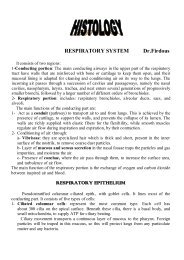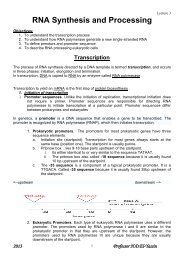PATHOLOGY OF THE FEMALE GENITAL SYSTEM VULVA
PATHOLOGY OF THE FEMALE GENITAL SYSTEM VULVA
PATHOLOGY OF THE FEMALE GENITAL SYSTEM VULVA
You also want an ePaper? Increase the reach of your titles
YUMPU automatically turns print PDFs into web optimized ePapers that Google loves.
<strong>PATHOLOGY</strong> <strong>OF</strong> <strong>THE</strong> <strong>FEMALE</strong> <strong>GENITAL</strong> <strong>SYSTEM</strong><strong>VULVA</strong>VULVITISThe most important infectious agents are1. Human papillomavirus (HPV), producing condylomata acuminata and vulvar intraepithelialneoplasia2. Herpes simplex genitalis (HSV 1 or 2), causing a vesicular eruption3. Gonococci producing suppurative infection of the vulvovaginal glandsContact Dermatitis is one of the most common causes of vulvar pruritus. It presents aserythematous weeping and crusting papules and plaques. Causes include urine, soaps,detergents, deodorants, etc.TUMORS1. Condylomas and Low-Grade Vulvar Intraepithelial Neoplasia (VIN)There are two biologic forms of anogenital warts (condylomas)a. Condylomata lata: are manifestations of secondary syphilis & are flat, and slightlyelevated. (Fig. 10-1)b. Condylomata accuminata: are viral (HPV) warts and appear as elevated warty or flat &wrinkled localized lesions.,red-pink lesions that measure up to several centimeters indiameter. (Fig. 10-2)Microscopically, there is acanthosis and hyper/parakeratosis, and koilocytosis. The latter aresquamous cells with perinuclear cytoplasmic vacuoles and nuclear angulation. The koilocytesare characteristic of HPV infection..2. High-Grade VIN and Carcinoma of the VulvaCarcinoma of the vulva is used to be seen mostly in elderly women. The vast majority ofvulvar carcinomas are of squamous type.VAGINAVaginitis is a relatively common problem that produces a vaginal discharge (leukorrhea).Many of the offenders are normal commensals that become pathogenic in conditions such asdiabetes, systemic antibiotic therapy, after abortion or pregnancy, or in AIDS.Gonorrheal vaginitis may occur and be transmitted to the newborn of the infected mother.Nonspecific atrophic vaginitis is a common cause of postmenopausal bleeding. It is due tolack of estrogenic support of the vaginal epithelium.Malignant Tumors1. Squamous cell carcinoma is very rare & usually occurs in elderly women, with riskfactors similar to those for cervical carcinoma2. Sarcoma botryoides (embryonal rhabdomyosarcoma), produces soft polypoid massesand is usually seen in infants and children younger 5 years of age. (Fig. 10-5)1
<strong>THE</strong> CERVIX UTERICervicitis is a very common condition that is associated with a mucopurulent discharge.Cytologic examination of the discharge reveals inflammatory cells admixed with cervicalepithelial cells, and possible microorganisms.It is often due to vaginal flora, streptococci, staphylococci, a E. coli.a Candida spp.. Neisseriagonorrhoeae, herpes simplex II (genitalis), and HPV. Many of these microorganisms aretransmitted sexually, and so the cervicitis may represent a sexually transmitted disease.The chronic form is very common consists of inflammation and epithelial regeneration.These changes may occur in both squamous and columnar mucosa.Cervical TumorsDespite dramatic improvements in early diagnosis and treatment, cervical carcinomacontinues to be one of the major causes of cancer-related deaths in women in the developingworld.Cervical Intraepithelial Neoplasia (CIN)The Pap smear, introduced 50 years ago by Papanicolaou, remains the most successful cancerscreening test ever developed. In populations that are screened regularly, cervical cancermortality is reduced by up to 99%.Nearly all invasive cervical squamous cell carcinomas arise from precursor epithelial changesreferred to as cervical intraepithelial neoplasia (CIN). Detection of CIN by the Pap smear atan early stage permits curative treatment.Cytological examination can detect CIN long before any abnormality can be seengrossly. CIN begins as low-grade lesion that may progress to higher grade CIN, or it is ahigh-grade lesions from the outset; this depends on the location of the HPV infection in thetransformation zone, the type of HPV infection .On the basis of histology, precancerous changes are graded as:CIN I: Mild dysplasiaCIN II: Moderate dysplasiaCIN III: Severe dysplasia/carcinoma in situThe current Bethesda system divides the precancerous lesions into only two groups:1. Low-grade SIL (SIL for squamous intraepithelial lesions), equivalent to CIN I2. High-grade SIL. Equivalent to CIN II & IIIProgression from low to high grade SIL may or may not occur. The higher the grade of CINthe greater the likelihood of progression to invasive carcinoma, this reaches to70% with CINIII.Epidemiology and Pathogenesis The peak age of CIN incidence is about 30 years, whereas that of invasive carcinoma isabout 45 years i.e. precancerous changes usually take many years to evolve into overtcarcinomas. Important risk factors for the development of CIN and invasive carcinoma are:1. Early age at first intercourse2. Multiple sexual partners3. Persistent infection by "high-risk" papilloma viruses4. Low socio-economic status5- cigarette smoking and immunodeficiency states such as AIDS.2
All of the above favor a sexually transmitted causative agent (HPV). which can be detectedby molecular techniques in nearly all precancerous and cancerous lesions. By contrast, HPV types 16 & 18,most common, usually integrate into the host genomewith subsequent inactivation of the tumor suppressor genes p53 and RB. The result is atransformed cell, capable of autonomous growth and (cancer progression).. Microscopic featuresCIN & Carcinoma in situ CIN begins with CIN I. This lesion is characterized by koilocytotic changes mostly in thesuperficial layers of the epithelium. Koilocytosis : is composed of nuclear hyperchromasiaand angulation with perinuclear vacuolization produced by cytopathic effect of HPV. Thedysplastic epithelium is limited to the lower third of the mucosa. In CIN II the dysplasia is more severe, involving the lower two-thirds of the mucosa. Thesuperficial layer in some cases shows the koilocytotic changes. CIN III shows dysplastic changes that affect virtually all layers of the epithelium. Surfacecells and their koilocytotic changes are usually absent. (Figs. 10-6). In time, dysplastic changes become more atypical and may extend into the endocervicalglands, but the alterations are confined to the epithelial layer and its glands. These changesconstitute carcinoma in situ. The next stage is invasive canrcinoma.The above progression sequences do not occur in all the cases.Cervical cytology and cervical colposcopy remain the basis of cervical cancerprevention.Invasive Carcinoma of the CervixThe most common cervical carcinomas are (in descending order)1. Squamous cell carcinomas (75%)2. Adenocarcinomas and adenosquamous carcinomas (20%)3. Small-cell neuroendocrine carcinomas (
BODY <strong>OF</strong> UTERUSEndometritisThis may be associated with retained products of conception subsequent to miscarriage ordelivery, or a foreign body such as an intrauterine device,frequently by flora ascending fromthe vaginal or anal region.Endometritis is either acute or chronic depending on whether there is a predominantneutrophilic or lymphoplasmacytic responseGenerally the diagnosis of chronic endometritis requires the presence of plasma cells(Fig 10-8).complications;menstrual abnormalities, infertility and ectopic pregnancy due to extension of the damaginginflammation to the fallopian tubes.AdenomyosisThis refers to the “invagination of the stratum basalis of endometrium down into themyometrium.” Nests of endometrial stroma, glands, or both, are found well down in themyometrium between the muscle bundles.Grossly;, the uterine wall often becomes thickened and the uterus is enlarged and globular.(Fig. 10-10) Because these glands derive from the stratum basalis, they do not undergocyclical bleeding. Nevertheless, marked adenomyosis may produce menorrhagia,dysmenorrhea, and pelvic pain before the onset of menstruation.EndometriosisThis is characterized by “the presence of endometrial glands and stroma in a locationoutside the endomyometrium.” It occurs in as many as 10% of women in theirreproductive years and in nearly half of women with infertility.It is frequently multifocal and may involve any tissue in the pelvis (ovaries, pouch ofDouglas, uterine ligaments, tubes, and rectovaginal septum), less frequently in more remotesites of the peritoneal cavity and about the umbilicus.Three possibilities have been suggested to explain the origin of these lesions.1. The regurgitation theory, currently the most accepted, proposes menstrual backflowthrough the fallopian tubes with subsequent implantation.2. The metaplastic theory proposes endometrial differentiation of coelomic epithelium.3. The vascular or lymphatic dissemination theory has been raised to explain extrapelvicendometriosis.Gross features Endometriosis almost always contains functioning endometrium, which undergoes cyclicbleeding. Because blood collects in these ectopic foci, they usually appear grossly as redblueto yellow-brown nodules,of variable size.. When the ovaries are involved, the lesions may form large, blood-filled cysts that aretransformed into so-called chocolate cysts as the blood ages (Fig. 10-11). fibrosis, adherence of pelvic structures, sealing of the tubal fimbriated ends, and distortionof the oviducts and ovaries.Microscopic features1. Endometrial glands2. Endometrial stroma, or3. Hemosiderin pigment.complications ;Extensive scarring of the oviducts and ovaries often causes sterility and Pain4
Dysfunctional Uterine Bleeding (DUB): is an abnormal bleeding in the absence of a welldefinedorganic lesion in the uterus. Examples of the causes of DUB include 1-Anovulatory cycles are very common at both ends or reproductive life, and have severalcause including1. Endocrine dysfunctions2. Ovarian lesions producing an excess of estrogen3. Malnutrition, obesity, or debilitating disease4. Severe physical or emotional stress.an anovulatory cycle leads to an excess of estrogen relative to progesterone; theendometrial glands may appear crowded with mild cystic changes with a relative scantstroma. (Fig. 10-12) The poorly supported endometrium partially collapses, with rupture ofspiral arteries, accounting for the bleeding. 2-Inadequate luteal phase. The corpus luteum may fail to mature normally or may regressprematurely, leading to a relative lack of progesterone. The endometrium under thesecircumstances shows delay in the development of the secretory changes expected at thedate of biopsy.Endometrial HyperplasiaThis is an exaggerated endometrial proliferation induced by sufficiently prolonged excess ofestrogen relative to progestin. The severity of hyperplasia is classified according to twoparametersa. architectural crowding of the glands & b. cytologic atypia.Accordingly there are three categories1. Simple hyperplasia2. Complex hyperplasia3. Atypical hyperplasiaSimple hyperplasia carries a negligible risk, while a woman with atypical hyperplasiahas a 20% risk of developing endometrial carcinoma. Thus When atypical hyperplasia isdiscovered, it must be carefully evaluated for the presence of cancer and must bemonitored by repeated endometrial biopsy.Potential contributors include1. Failure of ovulation, e.g. around the menopause2. Prolonged administration of estrogenic steroids3. Estrogen-producing ovarian lesions such as polycystic ovaries (Stein-Leventhal syndrome)4. Obesity, because adipose tissue processes steroid precursors into estrogens.Gross features In simple hyperplasia the endometrium is diffusely thickened (Fig. 10-13) In complex & atypical hyperplasia there is usually focal thickening of the endometrium.Microscopic features Simple hyperplasia involves both the glands & stroma; The glands are proliferative andsome are cystically dilated. Complex hyperplasia: there is focal glandular crowding with little stroma separating theproliferative glands. (Fig. 10-14). Simple and complex hyperplasias are further divided into atypical and non-atypical Atypical hyperplasia: characterized by atypical nuclei of the proliferative glands asevidenced by nuclear stratification, nuclear rounding and the presence of nucleoli.(Fig. 10-15)5
Tumors of the Endometrium and MyometriumThe most common neoplasms of the body of the uterus are1. Endometrial polyps,2. Smooth muscle tumors. Leiomyomas3. Endometrial carcinomas.All tend to produce bleeding from the uterus as the earliest manifestation.1-Endometrial Polyps are usually sessile,or pedunculated & may project from theendometrial mucosa into the uterine cavity & sometimes through the cervix into the vagina.Microscopically they are composed of cystically dilated glands with fibroblastic stroma.2-Leiomyomas are benign tumors that arise from the smooth muscle cells in themyometrium. Because of their firmness they are also called fibroids. They are the mostcommon benign tumor in females and are found in 30% to 50% of women duringreproductive lifeGross features: They are sharply circumscribed, firm gray-white masses with a characteristic whorled cutsurface. They may occur singly, but are often multiple tumors scattered within the uterus, rangingin size from small seedlings to massive neoplasms that dwarf the size of the uterus. Some are embedded within the myometrium (intramural), whereas others may lie directlybeneath the endometrium (submucosal) or directly beneath the serosa (subserosal). (Fig.10-17 A) Larger neoplasms may show foci of ischemic necrosis with cystic areas and hemorrhage .Microscopic features There are whorling bundles of smooth muscle cells. Foci of fibrosis, calcification, ischemic necrosis, cystic degeneration, and hemorrhage maybe present. (Fig. 10-17 B)Leiomyomas sometimes are asymptomatic. , and rarely transform into sarcomas.Leiomyosarcomas typically arise de novo from the mesenchymal cells of the myometrium.They are almost always solitary tumors, in contradistinction to the frequently multipleleiomyomas.Gross features (Fig. 10-18)1-The tumor is typically bulky soft, hemorrhagic, and necrotic2-It infiltrates the uterine wall.3-Some times it projects into the endometrial cavity.Microscopic features1-They show a wide range of differentiation, from those that closely resemble leiomyomato wildly anaplastic tumors.2-The diagnostic features of leiomyosarcoma include tumor necrosis, cytologic atypia, andmitotic activity.Endometrial Carcinoma (EMC)After the dramatic drop in the incidence of cervical carcinoma, EMC is currently the mostfrequent cancer occurring in the female genital tract.Epidemiology and PathogenesisEMC appears most frequently around the age of 60 years. There are two clinico-pathologicalsettings in which endometrial carcinomas arise:1. In perimenopausal women with estrogen excess; these are of endometrioid type2. In older women with endometrial atrophy; these are of serous type.6
Well-defined risk factors for endometrioid carcinoma include;a. Obesityb. Diabetesc. Hypertensiond. Infertility.e- estrogen replacement therapy and estrogen-secreting ovarian tumors increase the risk ofthis form of cancer.f-. Nearly all cases have mutations in the p53 tumor suppressor gene.Gross features EMC may be exophytic (fungating, polypoid) or infiltrative. (Fig. 10-19 A)Microscopic features The endometrioid carcinoma consists of malignant endometrial-like tubular glands ofvarying grades. Squamous metaplasia is frequent. Sometimes, the tumor is adenosquamouscarcinoma. (Fig. 10-19 B) may infiltrate the myometrium and enter vascular spaces, with metastases to regionallymph nodes. Serous carcinoma forms small tufts and papillary arrangements, and has much greatercytologic atypia. (Fig. 10-19 C).symptoms1-Patients with EMC presents with leukorrhea and irregular bleeding.2-uterus may become palpable, and in time it becomes fixed to surrounding structures .FALLOPIAN TUBESSalpingitis is inflammations of the tube and is almost always microbial in origin. streptococciand staphylococci, are now the major offenders..All forms of salpingitis may produce pelvic masses when the tubes become distended witheither exudate or, later, burned-out inflammatory debris and secretions.complicationsadhesions that increases the risk of tubal ectopic pregnany or infirtility.OVARIESFollicle cyst and Luteal Cyst are common and usually harmless lesions originate inunruptured graafian follicles or in follicles that have ruptured and immediately sealed. theyachieve diameters of 4 to 5 cm and may thus become palpable and produce pelvic pain. Theymay also rupture, producing intraperitoneal bleeding and acute abdominal symptoms. (Fig.10-22)Polycystic Ovaries (Stein-Leventhal syndrome)symptomsOligomenorrhea, hirsutism, infertility, and sometimes obesity may appear in young womensecondary to excessive production of androgens by multiple cystic follicles in the ovaries.Gross;The ovaries are usually twice the normal size, gray-white with a smooth outersurface,& studded with subcortical cysts 0.5 to 1.5 cm in diameter.Microscopically, there is a thickened, fibrotic tunica with underlying follicular cysts.Stigmata of previous ovulation are usually absent (corpora lutea or albicans). (Fig. 10-23)clinical findings ;1-In most patients there are excessive production of androgens,2-high concentrations of luteinizing hormone,3-low concentrations of follicle-stimulating hormone. These changes inhibit ovulation. Thediagnosis of this syndrome made on; both clinical & endocrine data are also required.7
TUMORS <strong>OF</strong> <strong>THE</strong> OVARYOvarian cancer is the fifth leading cause of cancer death in women.Tumors of the ovary are diverse and this diversity is attributable to the three cell types thatmake up the normal ovary:1. The surface (coelomic) covering epithelium2. The germ cells3. The sex cord/stromal cells.Each of these cell types gives rise to a variety of tumors (Fig. 10-24).1- Neoplasms of surface epithelial constitute the great majority of primary ovarian tumors(70%), and their malignant forms account for 90% of ovarian cancers.2-Germ-cell and sex cord/stromal cell tumors constitute 20% to 30% of ovarian tumors, butare collectively responsible for fewer than 10% of malignant tumors.Pathogenesis1-Nulliparity and family history are the two most important risk factors of epithelial ovariancancers.2-Higher incidence of carcinoma in unmarried women and married women with low parity.3-the majority of the hereditary cancers seem to be caused by mutations in BRCA1 andBRCA2 genes.4- Other molecular changes of ovarian neoplasms include HER2/NEU & K-RAS proteinsover-expression and p53 mutation. The latter is present in about 50% of all ovarian cancers.1-Surface Epithelial TumorsThese neoplasms are derived from the surface coelomic mesothelial covering of the ovary.With repeated ovulation and scarring the surface epithelium is pulled into the subjacentcortex, forming small epithelial cysts. These can undergo metaplasia with subsequentneoplastic transformation into the various histological types of the epithelial tumors.Benign lesions are usually cystic (cystadenoma) or can have an accompanying stromalcomponent (cystadenofibroma).Malignant tumors may also be cystic (cystadenocarcinoma) or solid (carcinoma).The surface epithelial tumors also have an intermediate, borderline category referred to astumors of low malignant potential. they have a better prognosis.Surface epithelial tumors are divided into serous, mucinous, endometrioid & Brenner tumors.A. Serous Tumors are the most frequent of the ovarian tumors.Gross features Most serous tumors are large, spherical, and cystic. About 25% of the benign forms are bilateral. These benign tumors display a smooth andglistening serosal covering. They are generally unilocular, but may be multilocular. The cystic spaces are usually filled with a clear serous fluid. papillary projections that become more marked in malignant tumors. (Fig. 10-25) the surface of cystadenocarcinoma shows nodular or warty irregularities that representcancerous penetration of the serosa. (Fig. 10-26)Microscopic features The benign tumors show a single layer of tall columnar epithelium that lines the cyst (s) Psammoma bodies (rounded laminated calcified structures) are common. In carcinoma, the lining cells display malignant features with invasion of the stroma.Papillary formations are complex and multilayered. Borderline tumors show milder cytologic atypia and typically, no stromal invasion.8
B. Mucinous Tumors differ from serous tumors essentially in the epithelium, which is ofmucin-secreting cells similar to those of the endocervical or intestinal mucosa. These tumorsoccur in women in the same age range as those with serous tumors, but the majority arebenign (80%), only 10% are malignant (cystadenocarcinomas), and 10% are of low malignantpotential.Gross features (Fig. 10-27) The incidence of bilateral ovarian involvement is much lower than for their serous type. Compared to their serous tumors, they show mucinous cystic contents and tend to be largerand multilocular but papillary formations are less common.Microscopic features (Fig. 10-27). Mucinous tumors are classified according to the type of the mucin-producing epithelialcells Serosal penetration and solid areas point to malignancy.Metastasis of mucinous tumor of the gastrointestinal tract to the ovaries (Krukenbergtumor) may also mimic an ovarian primary tumor.C. Endometrioid Tumors may be solid or cystic, but sometimes they develop as a massprojecting from the wall of an endometriotic cyst. They are distinguished by the formation oftubular glands (similar to those of the endometrium) within the linings of cystic spaces.Endometrioid tumors are usually malignant. They are bilateral in about 30% of cases, and upto 30% of women with these ovarian tumors have a concomitant endometrial carcinoma.D. Brenner Tumor is an uncommon, solid, usually unilateral ovarian tumor consisting of anabundant stroma containing nests of transitional epithelium resembling that of the urinarytract2-Germ Cell Tumors1. Dysgerminoma: these usually presents within 10 to 30 years of age. Their microscopicpicture is analogous to testicular seminoma. All are malignant but only 30% are aggressiveand disseminate..2. Yolk sac tumor & embryonal carcinoma are similar to their testicular counterparts.3. Choriocarcinoma presents within the first three decades of life. They are pathologicallyidentical to placental choriocarcinoma.4. Teratomas constitute up to 20% of ovarian tumors and arise in the first two decades of life;the younger the person, the greater is the likelihood of malignancy. However, more than 90%of these germ-cell neoplasms are benign mature cystic teratomas.Benign (Mature) Cystic Teratomas (Fig. 10-28) are characterized by differentiation oftotipotential germ cells into mature tissues representing all three germ cell layers: ectoderm,endoderm, and mesoderm. Usually there is the formation of a cyst lined by recognizableepidermis stuffed with adnexal appendages-hence the common designation dermoid cysts.They rarely exceed 10 cm in diameter. On opening, they are often filled with sebaceoussecretion and matted hair. Sometimes there is a nodular projection from which teeth protrude.Occasionally, foci of bone and cartilage, nests of bronchial or gastrointestinal epithelium,. .These tumors are prone to undergo torsion (10% of cases), producing an acute surgicalemergency.Immature Malignant Teratomas differ from mature cystic teratoma by being often bulky,predominantly solid or near-solid, and areas of necrosis.9
Gestational Trophoblastic TumorsThese are divided into four morphologic categories:1. Hydatidiform molea. Completeb. Incomplete2. Invasive mole3. Choriocarcinoma.All the three produce human chorionic gonadotropin (hCG), which can be detected in thecirculating blood and urine, at much higher titers than those found during normal pregnancy.The titers are progressively rising from hydatidiform mole to invasive mole tochoriocarcinoma. In addition to aiding diagnosis, the fall or rise in the level of the hormone inthe blood or urine can be used to monitor the effectiveness of treatment1. Hydatidiform Mole: Complete and PartialThe typical hydatidiform mole is a large mass of swollen chorionic villi,grossly as grapelike structures. The swollen villi are covered by varying amounts ofsometimes highly atypical chorionic epithelium. Two distinctive subtypes of moles have beencharacterized: complete and partial moles.A. The complete hydatidiform mole does not permit embryogenesis and thus does notcontain fetal parts. All of the chorionic villi are abnormal, and the chorionic epithelial cellsare diploid (46, XX or, uncommonly, 46, XY).B. The partial hydatidiform mole permits early embryogenesis and therefore contains fetalparts, has some normal chorionic villi, and is almost always triploid (e.g., 69, XXY).The two patterns result from abnormal fertilization; in both two spermatozoa fertlize an ovum;in a complete mole an empty egg is fertilized, which yields a diploid karyotype composed ofentirely paternal genes, while in a partial mole a normal egg is fertilized, resulting in a triploidkaryotype with a preponderance of paternal genes.early monitoring of pregnancies by ultrasound has lowered the gestational age ofdetection, leading to the more frequent diagnosis of "early complete hydatidiformmole."In either instance, elevations of hCG in the maternal blood and absence of fetal parts or fetalheart sounds are typical.Gross features uterine cavity is filled with a delicate, friable mass of thin-walled, translucent cysticstructures (Fig. 10-32). Fetal parts are rarely seen in complete moles but are common in partial moles.. (Fig. 10-33)Microscopic featuresThe complete mole There is hydropic swelling of all the chorionic villi, which are avascular. . The chorionic epithelium almost always shows some degree of proliferation of bothcytotrophoblast and syncytiotrophoblast (Fig. 10-32). Partial moles The villous edematous swelling involves only some of the villi and the trophoblasticproliferation is focal and slight. The villi of partial moles have a characteristic irregular scalloped margin. In most cases of partial mole there is evidence of an embryo or fetus. This may be in theform of fetal red blood cells in placental villi or, in some cases. (Fig. 10-33)11
10% of complete moles are invasive, but not more than 2% give rise to choriocarcinoma.Partial moles rarely give rise to choriocarcinomas. With complete moles, monitoring the postcurettageblood and urinary hCG concentrations2. Invasive Mole (Fig. 10-34) is a complete mole that is more invasive locally but do nothave the metastatic potential of a choriocarcinoma. An invasive mole retains hydropic villi,which penetrate the uterine wall deeply, possibly causing rupture and sometimes lifethreateninghemorrhage. Local spread to the broad ligament and vagina may also occur.Microscopically, the epithelium of the villi is hyperplastic and atypical.3. Choriocarcinoma is a very aggressive malignant tumor arises either from gestationalchorionic epithelium or, less frequently, from totipotential cells within the gonads orelsewhere. They are much more common in Asian and African countries, reaching afrequency of 1 in 2000 pregnancies. The risk is somewhat greater before age 20 and issignificantly elevated after age 40.Approximately 50% of choriocarcinomas complicate complete hyaditidiform moles; about25% arise after an abortion, and most of the remainder occur during what had been a normalpregnancy.clinical featuresMost cases are discovered by the appearance of a bloody or brownish discharge accompaniedby a rising titer of hCG, particularly the β-subunit, in blood and urine, and the absence ofmarked uterine enlargement,Gross features (Fig. 10-35) The tumor appears as very hemorrhagic, soft, nodular, necrotic masses within the uterus. Some times the primary lesion may self-destruct, and only the metastases tell the story.Microscopic features Cytotrophblastic cells tend to grow in clusters and sheets, separated by streaming masses ofsyncytiotrophoblast, forming the characteristic dimorphic growth pattern of mononucleatecytotrophoblast and syncytiotrophoblast. Hemorrhage and necrosis are usually present. chorionic villi are not formed.present-day chemotherapy has achieved nearly 100% cure.12
















